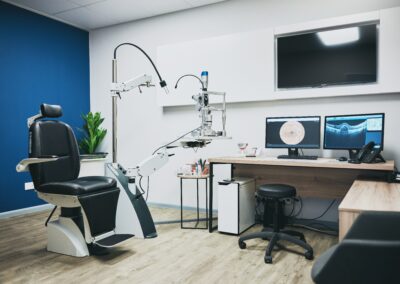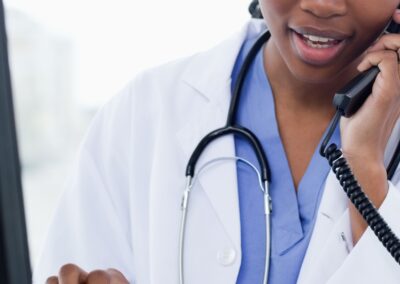‘The service is a good way of obtaining rapid support when there’s any doubt about what type of referral a patient requires. My overall experience was seamless; I downloaded the free app and used the line on the day of launch.’
The Suspected Head & Neck Cancer messaging service was launched in May 2023 to all clinicians in North Central London ICB.
Following this, we spoke with Denise Flynn, Lead Head & Neck and Thyroid Clinical Nurse Specialist (CNS) at University College London Hospitals NHS Foundation Trust, who manages this line, and a GP in Camden who recently used the service, to find out the benefits for clinicians and patients.
Suspected Head & Neck Cancer line statistics* :
Messages responded to in 49 minutes | 56% of reported outcomes indicate the patient avoiding a 2WW referral
Read the case study below, or click here to download the case study in PDF format.
What are the benefits of the Suspected Head & Neck Cancer line for clinicians in Primary Care?
‘It’s a very quick service that is easy to use. It’s a good way of obtaining rapid support when there’s any doubt about what type of referral a patient requires. My overall experience was seamless; I downloaded the free app and used the line on the day of launch.
‘As GPs, we carry a lot of diagnostic responsibility, and with any uncertainty, we should make the most of the support available, as imaging reports can be very technical.
‘The ease of sending the message and the quick turnaround on the guidance means that the patient’s anxiety will be lessened, and clinical concern reduced. The dialogues you can have with the specialists are straightforward and provide maximum benefit to the patients.’ – GP.
‘Head & Neck Oncology is a unique specialty which, when we look at the number of 2WW referrals received, has a low conversion rate to cancer. Part of the reason is that head and neck cancer symptoms are vague and can often indicate less sinister diagnoses. For example, head & neck cancer guidelines state that a presentation of a hoarse voice for three or more weeks requires a referral. But, nine times out of ten, patients with this symptom will not receive a head and neck cancer diagnosis. However, clinicians in Primary Care have no way of differentiating between broad symptoms which are suggestive of cancer and those that are not.
‘This service allows them to send messages to us, with imaging or patient photos attached, in their own time, which we can then review and advise whether a referral is needed, and, if so, what type.
‘We always aim to respond within one working day of receiving a message so clinicians can feel reassured that this won’t delay the patient’s pathway.’ – Denise Flynn.
Patient Example
‘I saw a patient who had been for a routine ultrasound on a thyroid lump. The report results indicated new nodules, but the grading system is not something I am familiar with interpreting, so I wasn’t sure if the nodules were suspicious.
‘I forwarded the report and scan via the Suspected Head & Neck Cancer messaging line for advice. I received a response from Denise, who advised that I should make a 2WW referral and that she would book the patient in for a fine needle aspiration without needing a clinic appointment first.
‘As a result, the patient’s care was fast-tracked, and they were put on the cancer pathway the same day, ensuring the patient got the care they needed fast.
‘If I had seen the patient before having access to this line, I would have needed to call the hospital switchboard and find a specialist in Head & Neck Oncology or Radiology to review the report. It would’ve been complicated to locate the right person; this streamlines the process and makes it significantly easier.’ – GP.
‘Thyroid nodules, by nature, are very common conditions that often don’t require intervention. But if they do, there is no way for a clinician in Primary Care to determine that. Patients with these conditions need to undergo a fine needle aspiration to establish the state of cancer, and these diagnostic tests are not readily available to Primary Care.
‘Thyroid nodules are classified by the U system, with U1-U2 categorised as normal/benign, U4 as suspicious, and U5 as more likely cancerous.
‘This patient’s ultrasound report graded their thyroid nodule as U3, which is indeterminate. Therefore, we needed to repeat the ultrasound under the care of a specialist head and neck radiologist and take a sample of the nodule to show us a complete picture.
‘Once we had the cytology result from the fine needle aspiration, it indicated a suspected cancer that needed a multidisciplinary team (MDT) discussion.
‘This service is really beneficial for patients in that grey area where a diagnosis is not clear-cut.
‘If this patient had presented before introducing this service, they would have been referred on the normal 2WW pathway for a first appointment which is expected within 14 days. Then potentially up to another two weeks to undergo an ultrasound. It takes another one to two weeks for us to receive the full ultrasound report, which we can then take to the MDT meeting to discuss a patient care plan.
‘Whereas on this occasion, after speaking with the patient’s GP, we ordered the ultrasound test that same day. The ultrasound took place a week later, with the results flagged immediately. We took the results to our MDT discussion, so when we saw the patient in that first appointment, we already had a complete treatment plan ready. So, for a pathway that can take up to six weeks to progress treatment, this line enabled us to do it in four. This significantly reduces the wait time for patients.’ – Denise Flynn.
What are the benefits for the Head & Neck Oncology Team?
‘Before the implementation of this line, we didn’t receive many queries for advice. There was no way to discuss patients or flag patients with suspected cancer and no way of accessing next-day or next-week appointments for patients who needed them. Regardless of their urgency, all referrals go into the same system, and only one in ten patients will require specialist attention.
‘Providing the messaging service is not arduous or demanding. This is a same-day messaging service with a rota covered by the CNS Team as the first point of contact.
‘Messages come in clearly, and we’re informed via an email notification. The messaging function allows clinicians to attach patient photos, as well as imaging reports, which means that suspected cancers can potentially be identified. Mouth cancers are visual in their presentation, and so when clinicians send us patient photos, this allows us to immediately conduct an assessment which would never be done without that visual element.
‘We encourage the attachment of photographs as these can be exported as PDFs with the accompanying message(s) and added to the patient’s clinical record.
‘We currently have an open case where the images have been added to the patient’s record for observation, and the clinician will send additional photos in six weeks so that we can measure differences and advise accordingly.
‘It’s of huge benefit to the patient because if there are significant changes, we can advise a referral on the 2WW pathway, and the patient will be appointed a faster diagnosis keyworker.’ – Denise Flynn.
What advice would you give clinicians hesitant to use Consultant Connect?
‘It’s not extra work because we’re discussing patients that would have been referred to us anyway. We just ensure the patient receives the right care on the right pathway.
‘When filling out the 2WW form, the clinician can add that they have discussed this case via Consultant Connect to ensure the patient has a faster diagnosis pathway. The CNS Team will inform the booking team to expect the referral and schedule investigations and appointments accordingly.
‘At the beginning of 2023, we conducted an audit. It showed that out of 565 referrals, 23 were confirmed cancers. Consultant Connect will enable us to advise clinicians and help patients without overloading our system. It’s convenient and non-invasive and does not pose a big commitment, and you can choose the way you provide advice to match your team’s activity.’ – Denise Flynn.
*Statistics correct as of July 2025.
Please note that statistics within the PDF may differ from those on the website as web content is updated more frequently to reflect the most current data.
Click here to view and download a PDF version of this case study.
If you would like to discuss setting up Messaging A&G in your area, please email hello@consultantconnect.org.uk or call 01865 261467.
Related materials:




